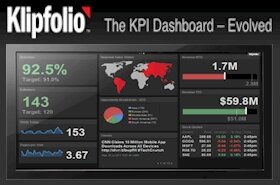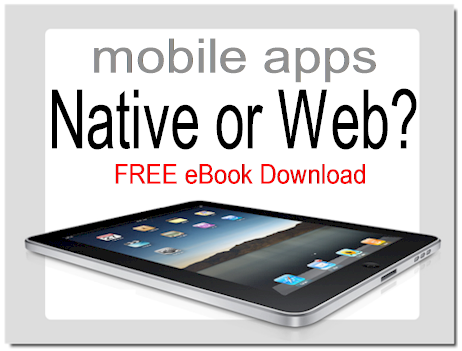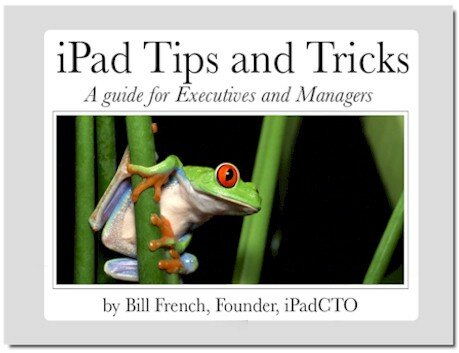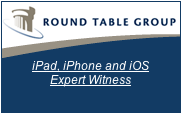It’s no secret that iPad has become one of the best delivery tools for business intelligence (BI). Its form, lightweight design, and connectivity has caused rapid adoption by companies that need to extend the reach of their business intelligence data and provide pervasive access to performance results. Indeed, the executive suite and top managers have seen how accessibility to performance results can improve operations and increase management productivity.
iPad-enabled BI solutions from companies such as RoamBI, Microstrategy, and QlikView typically focus on detailed operational data and the deep details of performance at very granular levels. However, there is undoubtedly significant demand for a slice of BI related to high-level strategic goals, objectives, and targeted performance indicators.
An approach to managing and reporting on strategic goals used by more than 60% of the Fortune 500 and thousands of smaller companies, is known as the Balanced Scorecard. The balanced scorecard is a methodology, not a product; it’s a strategic planning and management model used to align business activities to the vision and strategy of the organization, improve internal and external communications, and monitor organizational performance against strategic goals.
According to BalancedScorecard.org,
“It was originated by Drs. Robert Kaplan (Harvard Business School) and David Norton as a performance measurement framework that added strategic non-financial performance measures to traditional financial metrics to give managers and executives a more ‘balanced’ view of organizational performance. While the phrase balanced scorecard was coined in the early 1990s, the roots of the this type of approach are deep, and include the pioneering work of General Electric on performance measurement reporting in the 1950’s and the work of French process engineers (who created the Tableau de Bord – literally, a “dashboard” of performance measures) in the early part of the 20th century.”
The balanced scorecard has evolved from a simple performance measurement framework to a full strategic planning and management system. There are entire software suites devoted to this methodology and interestingly, there are some very simple systems based on Excel spreadsheets.
The modern version of the balanced scorecard system transforms an organization’s strategic plan from an attractive but passive document into the “marching orders” for the organization on a daily basis. It provides a framework that not only provides performance measurements, but helps business planners identify what should be done as well as what should be measured. It enables executives to truly execute their strategies.
The balanced scorecard system is apparently agile enough to be beneficial in extremely simple implementation formats, although I would guess that the back of an envelope is not likely to be sustainable. Certainly, it’s possible to utilize balanced scorecard with a pad of paper and pen, and therein lies the iPad opportunity.
Sometimes less is more. ironically, iPad has proven this. A comprehensive balanced scorecard implementation running on a desktop or laptop is probably useful to certain managers. However, most managerial and executive roles would likely benefit from a lightweight implementation even if it wasn’t a comprehensive solution. This is what Business and Strategy Consultoria (BsC) is betting on.
BsC, located in Madrid, Spain recently announced the release of Balanced Scorecard for iPad.

The user interface is surprisingly clean and well-designed. Typically, products of this genre (i.e., financial utilities developed by domain experts in this field) are clunky and difficult to use. It’s clear that BsC has paid close attention to design and usability requirements. Popup dialogs, icon elements, and the overall flow of the app is clean and concise – a pleasure to use.
The general presentation of the scorecard performance indicators is also appealing, ensuring this will not likely become shelfware in your organization. What impressed me the most about this app is its agility; it can seemingly be shaped to track and manage any type of strategic or tactical objectives. Perhaps this is a reflection of the balanced scorecard methodology, but if it is, the developers capture this essence very effectively.
The reports are relatively simple in design, but highly functional. I was disappointed to find few report customization options. In my view, reporting should be fluid, allowing organizations to shape information to closely match their reporting requirements. Imagine a template model for each report that would provide better reporting consistency across the organization. A configurable reporting framework would also make it possible to export information in formats that could be integrated with other systems.

I’m not a balanced scorecard expert by any stretch, but my sense is that the developers followed the philosophical aspects of this methodology with precision. In my research I found no evidence that this app deviates from generally accepted balanced scorecard practices. I recommend a little training or at least some light reading in the balanced scorecard methodology before diving into this app. With a few hours of research at BalancedScorecard.org, I was feeling pretty comfortable using the app.
In spite of the obvious adherence to the balanced scorecard pholosophy, there are some things that could be improved relating to functional agility.
Without a doubt users will expect a way to export and import balanced scorecard projects. There’s no apparent way to do this in version 1.1. Setting aside the obvious collaboration benefits from an import/export option, how could you backup your projects without this feature? There is an option to email reports as PDF documents, but that seems to be the export ceiling in version 1.1. Lack of export and a backup (and restore or import) model is a significant oversight that needs to be addressed quickly.
Taking this idea to the next level, it would make sense to read and write balanced scorecard projects to cloud services such as Box, DropBox, and iDisk. This would mitigate security issues and provide better collaboration and enterprise-grade data management opportunities. Ideally, the app should provide a switch to force cloud integration, a feature that CIOs will appreciate. The app includes an optional security feature that provides an additional access defense layer, but I have a hunch with a jailbreak and 6 minutes of research, the corporate data would be in a thief’s hands.
Over the horizon, this tool should provide integration gateways for automating the integration performance results to mitigate data entry on the iPad, or sharing information with other apps and web services. This would make it possible for data visualization apps such as RoamBI to participate through standard app protocols. While the app developers would love to see an app purchased by everyone who needs to see balanced scorecard results, distribution and sharing of balanced scorecard results to people who don’t necessarily own the Balanced Scorecard app, is critically important and will likely increase adoption.




















[...] This post was mentioned on Twitter by Bill French, Web Security News, Visibility News, Alan Potts, bscipad and others. bscipad said: Balanced Scorecard for iPad, A Simplified BI Dashboard for Strategic Planning http://bit.ly/ehs8ID [...]
Really Good Article!!
This app help us to control our Business with our IPads for a little price.
Thanks!
[...] times far more difficult than building the strategy itself. Our own product strives to achieve simplification for monitoring results but we still have many new ideas and work ahead of [...]
[...] an earlier review of Balanced Scorcard by iPadCTO, they took specific notice about our interface – it is clean [...]
Thanks for the great article on using scorecard and dashboard tools on my ipad-
Balanced scorecard software options are growing at an incredible rate – especially as more and more social and nonprofit sector organizations utilize the inexpensive tools to manage ever increasing data-requests and scrutiny from the media, ratings sites, and regulators.
We recommend that every buyer should sample and demo a few alternatives to fully understand each systems capabilities and to build internal momentum behind implementing and using a new method of communication, collaboration, and management.
One option you might try is ClearPoint Strategy.
ClearPoint Strategy is a web-based balanced scorecard, dashboard, and performance management solution. ClearPoint has a highly effective US based support team that is eager to help you get started. We also offer a number of example templates to browse and can add your strategic plan, charts, or even add other users while you get comfortable using the software.
Visit ClearPoint at: http://www.ClearPointStrategy.com
Best of luck!